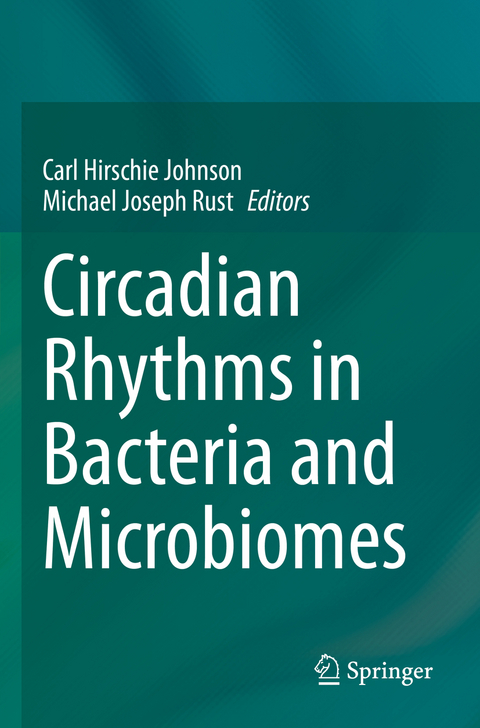
Circadian Rhythms in Bacteria and Microbiomes
Springer International Publishing (Verlag)
978-3-030-72160-2 (ISBN)
This book addresses multiple aspects of biological clocks in prokaryotes.
The first part of the book deals with the circadian clock system in cyanobacteria, i.e. the pioneer of bacterial clocks. Starting with the history and background of cyanobacteria and circadian rhythms in microorganisms, the topics range from the molecular basis, structure and evolution of the circadian clock to modelling approaches, Kai systems in cyanobacteria and biotechnological applications.
In the second part, emergent timekeeping properties of bacteria in microbiomes and bacteria other than cyanobacteria are discussed.
Since the discovery of circadian rhythms in cyanobacteria in the late 1980s, the field has exploded with new information. The cyanobacterial model system for studying circadian rhythms (Synechococcus elongatus), has allowed a detailed genetic dissection of the bacterial clock due to state-of-the-art methods in molecular, structural, and evolutionary biology. Cutting-edge research spanning from cyanobacteria and circadian phenomena in other kinds of bacteria, to microbiomes has now given the field another major boost.
This book is aimed at junior and senior researchers alike. Students or researchers new to the field of biological clocks in prokaryotes will get a comprehensive overview, while more experienced researchers will get an update on the latest developments.
Carl Hirschie Johnson earned his B.A. at the University of Texas, followed by graduate work with Colin Pittendrigh, a pioneer of chronobiology, at Stanford University. A postdoctoral fellowship with the clocks and bioluminescence expert J. Woodland ('Woody') Hastings at Harvard University completed his training. Johnson is now Cornelius Vanderbilt Professor of Biological Sciences at Vanderbilt University, and his laboratory studies circadian biological clocks from perspectives ranging from molecules (biochemistry and biophysics) to populations (evolution and adaptive fitness). He served as President of the Society for Research on Biological Rhythms (SRBR), the major international society of chronobiologists in 2012-2014. Michael Rust earned his B.S. in Physics & Mathematics at Harvey Mudd College, Claremont, CA, USA, and did his Ph.D. in Physics at Harvard University, Cambridge, MA. Michael Rust is now Associate Professor in the Department of Molecular Genetics and Cell Biology & the Department of Physics in the University of Chicago, Chicago, Illinois. He is also the Director of the Institute for Biophysical Dynamics. Dr. Rust and his research group have the goal of combining experimental measurements with mathematical analyses to understand dynamical behavior in biology. A major focus of the lab is the circadian clock in cyanobacteria, where a system of purified proteins is capable of generating a remarkably robust 24-hour oscillation in protein phosphorylation that is used to organize cellular physiology.
Chapter 1. Introduction.- Chapter 2. Around the Circadian Clock: Review and Preview.- Chapter 3. A retrospective: on disproving the transcription-translation feedback loop model in cyanobacteria.- Chapter 4. Mechanistic Aspects of the Cyanobacterial Circadian Clock.- Chapter 5. Mechanism of the cyanobacterial circadian clock protein KaiC to measure 24 hours.- Chapter 6. Oscillation and Input Compensation in the Cyanobacterial Kai Proteins.- Chapter 7. Insights into the Evolution of Circadian Clocks Gleaned from Bacteria.- Chapter 8. Reasons for Seeking Information on the Molecular Structure and Dynamics of Circadian Clock Components in Cyanobacteria.- Chapter 9. Single-molecule methods applied to circadian proteins with special on atomic force microscopy.- Chapter 10. Diversity of timing systems in Cyanobacteria and beyond.- Chapter 11. An In Vitro Approach to Elucidating Clock-modulating Metabolites.- Chapter 12. Damped Oscillation in the Cyanobacterial Clock System.- Chapter 13. Roles of phosphorylation of KaiC in the cyanobacterial circadian clock.- Chapter 14. Reprogramming metabolic networks and manipulating circadian clocks for biotechnological applications.- Chapter 15. Insights from Mathematical Modeling/Simulations of the in vitro KaiABC clock.- Chapter 16. Basic Biology of Rhythms & the Microbiome.- Chapter 17. Disease Implications of the Circadian Clocks and Microbiota Interface.- Chapter 18. Circadian organization of the gut commensal bacterium Klebsiella aerogenes.- Chapter 19. Daily rhythmicity in coastal microbial mats.- Chapter 20. Daily and Seasonal Rhythms of Marine Phages of Cyanobacteria.
| Erscheinungsdatum | 24.06.2022 |
|---|---|
| Zusatzinfo | XXIV, 415 p. 89 illus., 83 illus. in color. |
| Verlagsort | Cham |
| Sprache | englisch |
| Maße | 155 x 235 mm |
| Gewicht | 670 g |
| Themenwelt | Naturwissenschaften ► Biologie ► Evolution |
| Naturwissenschaften ► Biologie ► Mikrobiologie / Immunologie | |
| Naturwissenschaften ► Biologie ► Zellbiologie | |
| Schlagworte | Adaptive Fitness • Biological Clock • chronobiology • circadian • Circadian clock • Circadian Phosphorylation • Circadian Rhythm • cyanobacteria • Evolution of Clocks • Kai • Microbiome and Clocks |
| ISBN-10 | 3-030-72160-4 / 3030721604 |
| ISBN-13 | 978-3-030-72160-2 / 9783030721602 |
| Zustand | Neuware |
| Haben Sie eine Frage zum Produkt? |
aus dem Bereich


